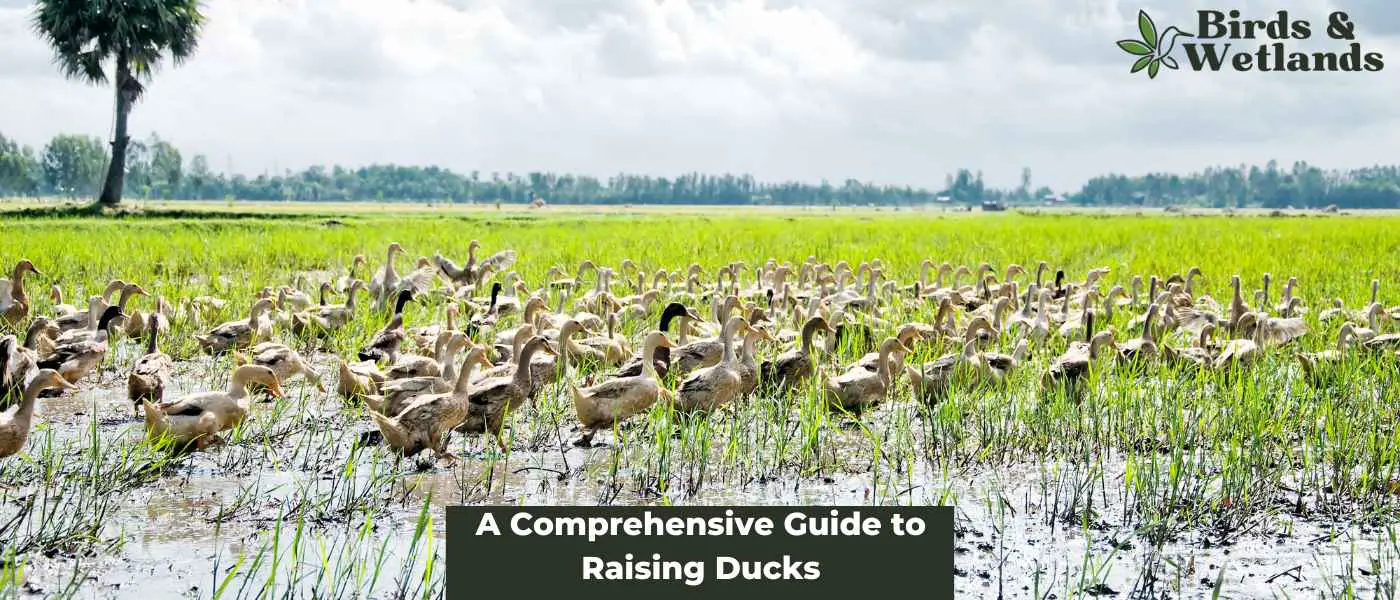Raising ducks can be a rewarding experience, whether for pets, eggs, meat, or pest control. Ducks require proper housing, nutrition, and care to thrive. A predator-proof duck house or coop is crucial. They need a balanced diet, including commercial waterfowl feed and occasional treats like veggies or grains. Access to fresh water for drinking and bathing is also important. Regular health checks and vaccinations can prevent diseases.
Before diving into the world of duck-raising, it’s important to understand the basics of their care and management. This includes selecting a suitable breed, providing adequate housing and nutrition, and understanding their health needs.
Understanding the differences between ducks and common poultry such as chickens can help ensure a smoother experience for both the ducks and their caretakers.
Key Takeaways
Ducks are different from chickens and require some modifications in their rearing. However, ducks and chickens can be raised together.
Ducklings grow quickly, consume a significant amount of starter ration, and can be moved outdoors earlier than chicks.
Ducks are excellent foragers, reliable egg layers, and quite easy to keep. They also control the insect population in your yard.
Ducks are sociable creatures that thrive best when raised in groups.
Regular health checks and timely vaccinations can go a long way in ensuring a healthy flock.
Duck housing needs to be secure to protect them from duck predators and ventilated to prevent odor build-up.
Ducks do not need perches like chickens, as they do not roost. Instead, provide straw for nesting.
Access to water for dipping their bills, preening, and swimming is crucial for ducks.
Ducks should be fed with a diet primarily composed of grasses and plants. Avoid feeding them bread.
Domestic duck breeds usually cannot fly high, so fencing does not need to be too tall unless to protect them from predators.
Depending on the breed, a duck can lay anywhere between 100 to 300 eggs annually. Duck eggs are considered excellent for baking due to their slightly higher fat content.
| Duck Needs | Description |
|---|---|
| Housing | Secure and well-ventilated housing, with straw for nesting |
| Perch | Not needed as ducks do not roost |
| Water | Access to water for dipping their bills and swimming is vital |
| Food | Primarily grasses and plants. Bread should be avoided |
| Fencing | Low fencing is typically sufficient unless there is a risk of predators |
| Egg Production | Ducks can lay between 100 to 300 eggs annually, depending on the breed |
Do’s of Raising Ducks
- Do provide a predator-proof shelter: Ducks need a safe place to sleep at night and escape from harsh weather. The shelter should be secure from predators, well-ventilated, and spacious enough for each duck to have adequate room.
- Do ensure access to clean water: Ducks need water not just for drinking, but also for bathing. Ducks use water to keep their feathers clean, which is essential for their ability to fly and regulate body temperature.
- Do provide a balanced diet: Ducks require a nutritious diet for optimal health. Avoid feeding them bread as it lacks the necessary nutrients and can cause health problems. Instead, provide a diet rich in grains, greens, and specially formulated duck pellets.
- Do understand their social behavior: Ducks are social creatures that thrive in groups. Understanding their behavior will help you better cater to their needs and reduce stress in the flock.
- Do keep their living area clean: Regular cleaning of their pen reduces the risk of disease. Make sure to frequently replace their bedding and clean their food and water containers.
Don’ts of Raising Ducks:
- Don’t ignore their social needs: Ducks are social animals and need companionship. Never keep a single duck as it can lead to loneliness and stress. Ideally, keep a minimum of three ducks.
- Don’t forget to check for diseases: Regularly monitor your ducks for signs of disease. Early detection can make treatment more effective. Common signs of disease include changes in behavior, eating habits, or physical appearance.
- Don’t release domestic ducks into the wild: Domestic ducks lack the survival skills of their wild counterparts and can spread disease to wild populations. If you can no longer care for your ducks, reach out to a local animal rescue or farm.
- Don’t neglect regular veterinary care: Ducks should have regular check-ups with a vet experienced in avian care. This will ensure they stay healthy and any potential issues are caught early.
- Don’t underestimate the commitment: Raising ducks is a long-term commitment that requires time, effort, and resources. Make sure you’re fully prepared before deciding to raise ducks.
Understanding Duck Behavior
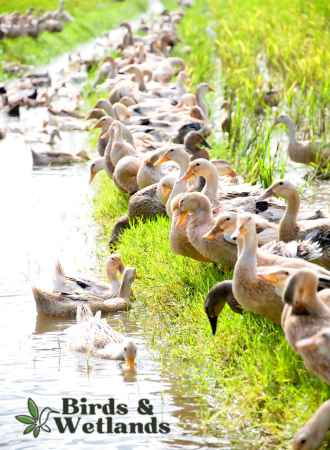
Before embarking on your duck-raising journey, it’s crucial to familiarize yourself with the typical behaviors of these unique birds. Recognizing their instincts, habits, and communication methods will not only help you better meet their needs but also allow you to create a more harmonious living environment for your ducks.
Duck Social Dynamics
Ducks are inherently social creatures and thrive best in a flock. They form close bonds with their fellow ducks and can experience stress or loneliness if kept in isolation. The recommended minimum number of ducks to keep together is three, to ensure they always have company.
Foraging and Feeding
Ducks are natural-born foragers and spend a significant part of their day searching for food. They have a broad diet and love to dabble – a behavior where they filter food and other objects from the surface of water or mud.
Communication and Vocalization
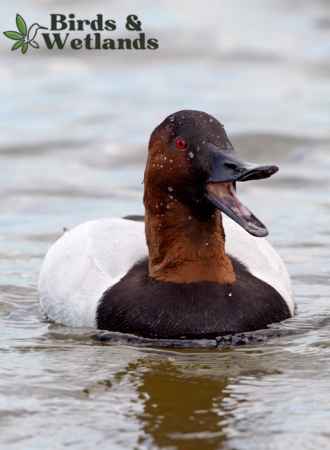
Ducks communicate through a variety of vocalizations and body language cues. For instance, a loud quack often signifies excitement or distress, while soft peeping sounds indicate contentment. Understanding these signals can help you monitor their well-being and respond to their needs appropriately.
Predator Awareness
Ducks have a strong instinct for self-preservation. They’re always on high alert for potential threats and will quickly retreat to safety at the first sign of danger. It’s important to respect this instinct and provide a secure, predator-proof environment for your flock.
Swimming and Preening
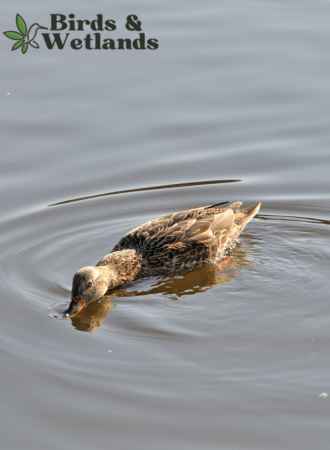
Swimming is not just a fun activity for ducks but also an essential part of their hygiene routine. They’ll often follow a swim with preening, a behavior where they use their beaks to clean and align their feathers. Providing your ducks with a clean water source for these activities is crucial.
By understanding these key aspects of duck behavior, you’ll be better equipped to provide a nurturing and stimulating environment for your ducks. This knowledge can make the process of raising ducks more rewarding and enjoyable, while also promoting the overall health and happiness of your flock.
Choosing the Right Duck Breed
When raising ducks, it’s vital to choose the right breed to suit your needs and preferences. The following sub-sections will discuss popular duck breeds, including their characteristics and advantages.
Pekin Duck
The Pekin duck is a popular breed known for its tasty meat and quick growth. It takes slightly longer to mature than broiler chickens, but they are still considered efficient meat producers. With their white feathers and friendly demeanor, Pekin ducks are also occasionally kept as pets.
Khaki Campbell

Khaki Campbells are excellent egg layers, producing around 5-6 cream-colored eggs per week, or up to 340 eggs per year under ideal conditions. These ducks are perfect for those looking to raise ducks for egg production on their small farm or homestead.
Muscovy Duck
Muscovy ducks are a top choice for meat production. They have lean and flavorful meat, and are known for being self-sufficient foragers. However, it’s important to note that Muscovy ducks can take months longer to mature than broiler chickens.
Welsh Harlequin
Welsh Harlequins are another great option for egg production. They are calm, friendly, and good foragers. As a bonus, Welsh Harlequins have beautiful plumage, making them an attractive addition to any backyard or farm.
Aylesbury
The Aylesbury duck is a large and predominantly white-feathered duck breed, valued for its tender, flavorful meat. Originally from England, they have a calm temperament and adapt well to various environments.
Cayuga
Cayuga ducks are known for their striking appearance with iridescent black-green feathers. They make great pets due to their docile nature and are also favored as backyard/homestead birds. Cayugas can be decent egg layers, producing 100-150 eggs per year.
Silver Appleyard
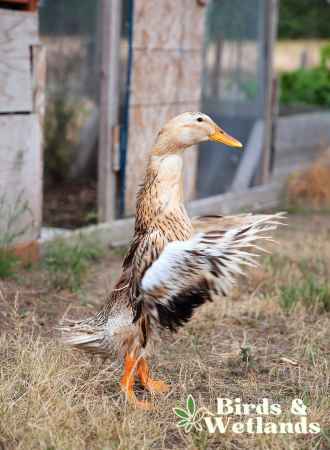
Silver Appleyard ducks are an attractive and versatile breed. They’re good foragers and have a calm temperament making them suitable for backyard poultry keepers. With their decent egg production and quality meat, Silver Appleyards are considered a dual-purpose duck.
Runners
Runner ducks, known for their unique upright stance, are highly efficient egg layers. They are active foragers and have a friendly nature. Runners can produce 150-300 eggs per year, making them an ideal choice for those interested in raising ducks for eggs.
| Duck Breed | Origin | Primary Purpose | Egg Production | Distinct Features |
|---|---|---|---|---|
| Muscovy | South America | Meat | Low | Red, bumpy face |
| Mallard | Worldwide | Decorative, Meat | Moderate | Wild breed, varied plumage |
| Pekin | China | Meat, Eggs | High | Large, white, calm and hardy |
| Call Duck | N/A | Pets | Low | Small, loud call, friendly |
| Khaki Campbell | N/A | Eggs | Very high | Excellent egg layer |
| Cayuga | America | Meat | Moderate | Glossy black-green feathers, excellent foragers |
| Mallard (dabbling) | Worldwide | Decorative, Meat | Moderate | Males display striking green heads, bright yellow bills |
How Many Ducks?
The size of your duck flock will really depend on you and the area you have available. Firstly, consider the purpose of raising ducks. Are you planning to keep them primarily for egg production, meat, or simply as pets? Each purpose may require a different number of ducks.
For egg production, consider the number of eggs you and your family consume on a regular basis. Ducks are known to be prolific layers, with some breeds producing upwards of 200 eggs per year. Assess your egg consumption needs and calculate how many ducks would be required to meet that demand.
If your aim is to raise ducks for meat, determine the amount of meat you anticipate consuming or selling. This will help you estimate the number of ducks needed to achieve your desired meat yield.
When raising ducks as pets or for ornamental purposes, the number of ducks can vary widely depending on your personal preference and the available space. Some individuals enjoy the companionship of a few ducks, while others prefer a larger flock for aesthetic reasons.
Another crucial consideration is the space available for your ducks. Ducks require sufficient room to roam, access to water, and suitable shelter. Overcrowding can lead to stress, unsanitary conditions, and potential health issues. As a general rule, provide at least 4 to 6 square feet of space per duck to ensure their well-being.
Check local regulations or zoning restrictions that may impose limits on the number of ducks you can keep in your area. Some municipalities have guidelines regarding the maximum number of poultry allowed per acre or specific restrictions for urban or residential areas.
Keep in mind that ducks are social animals and thrive in the company of their own kind. It is recommended to keep a minimum of two ducks to provide companionship and prevent loneliness.
How many ducks should you get?
Starting with a small flock of 2-4 ducks is typically a good number for beginners. Ducks are social creatures and do best in groups. However, the size of your flock ultimately depends on your available space, purpose for raising ducks, and local regulations.
Should you get male or female ducks?
The choice between male ducks and female ducks depends on your purpose for raising them. Female ducks, or hens, are excellent layers and ideal if you want a regular supply of eggs. A Male duck, or drake, is usually larger, less noisy, and doesn’t lay eggs.
What ratio of male-to-female ducks should you get?
If you’re keeping backyard ducks for eggs and not breeding, it’s best to only keep females. If you plan to breed your ducks, a common ratio is one drake for every 3-6 ducks. Too many drakes can lead to aggressive behavior and stress for the hens. Always monitor your flock’s dynamics.
Housing and Pen Setup
The housing for ducks should be safe, comfortable, and meet all their needs. A good housing setup can contribute significantly to the health and productivity of your flock.
Coop Design and Ventilation
When designing a duck coop, it’s essential to consider proper ventilation. Ducks require good airflow to maintain their health and well-being. Ensure that the coop has adequate space for all ducks, with enough room for them to move around comfortably.
The coop should have vents or windows, positioned strategically to provide fresh air without exposing the ducks to direct drafts, especially during colder months.
TRIXIE Pet Products Natura Duck Coop
Are you looking for a reliable, safe, and accommodating living space for your ducks? The TRIXIE Pet Products Natura Duck Coop is the perfect abode that combines function, comfort, and durability, ensuring your ducks enjoy their surroundings.

Pros
- Spacious Design: The TRIXIE Pet Products Natura Duck Coop provides ample space for your ducks to roam and rest comfortably, promoting their well-being and happiness.
- Convenient Cleaning: With a pull-out plastic tray, this duck coop makes cleaning a breeze, helping maintain hygiene without the usual hassles.
- Robust Construction: Made of glazed pine, this coop is built to withstand the elements, ensuring a long-lasting and sturdy home for your ducks.
- Security: The hinged roof with locking arm can be opened from above, providing easy access while also ensuring your ducks’ security against potential predators.
- Easy Assembly: With all necessary hardware included and a detailed instruction guide, setting up your TRIXIE Pet Products Natura Duck Coop is a simple and straightforward process.
Cons
- Size Limitation: While the TRIXIE Pet Products Natura Duck Coop offers ample space, it may not be suitable for a large flock of ducks. Owners with a significant number of ducks may need to consider additional or larger housing options.
- Lack of Insulation: The design of the coop may not provide adequate insulation in extremely cold climates. Additional measures may be necessary to keep your ducks warm during harsh winters.
Nesting Area and Boxes
Providing ducks with a dedicated nesting area is crucial for their comfort and the production of healthy eggs. The nesting area should be clean, dry, and protected from the elements. It’s a good idea to provide separate nesting boxes for each duck, while making sure there’s enough space between them to prevent overcrowding.
Nesting boxes can be made from various materials, such as wood, plastic, or metal. Just ensure there are no sharp edges that could injure the ducks. Fill the boxes with soft, absorbent materials like straw or shavings, which can be easily replaced as needed.
Woodlink Cedar Duck Nesting Box
Attract ducks to your wetland area and provide them with a cozy, secure nesting space using the expertly crafted Woodlink Cedar Duck House, made with high-quality materials in the USA.

Pros
- Ornithologically designed: This nesting box is specifically created for ducks, ensuring an optimal environment for them to thrive.
- High-quality materials: Made from re-forested, kiln-dried, inland red cedar, the Woodlink Cedar Duck House is both durable and eco-friendly.
- Easy to install: The nesting box comes fully assembled, with screws included for quick and easy mounting.
- Made in the USA: Take pride in knowing that you are supporting a product that is made domestically, ensuring top-notch quality and craftsmanship.
- Versatile use: While designed specifically for ducks, this nesting box can also be occupied by other species like screech owls, squirrels, and pileated woodpeckers.
Cons
- Mounting height: Users must research and choose the appropriate mounting height (usually 4-6 feet above the ground) and install a baffle on the post to deter predators like raccoons and cats.
- Limited viewing access: Although the front of the box can be opened for viewing, it is important not to disturb nesting birds, which may limit opportunities for observation.
Fencing and Protection from Predators
Protecting your ducks from predators such as raccoons and mink is of utmost importance. When constructing a secure run or pen, it’s highly recommended to use hardware cloth instead of chicken wire, as it offers better protection against potential intruders. Trenching the hardware cloth beneath the floor of the duck coop and around the entire perimeter of the housing structure and run can help safeguard against burrowing predators.
Installing guards on any vents and windows can limit access for predators while still allowing for proper ventilation. It’s a good idea to equip the coop with strong, secure locks to prevent raccoons or other intelligent creatures from opening the door.
Feeding and Nutrition
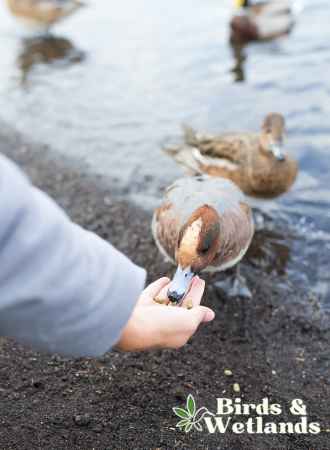
Raising healthy ducks requires providing them with a balanced diet. A combination of good nutrition and proper management is essential. Maximum efficiency can be obtained by using commercially prepared duck feeds, available at most local feed stores. Grown ducks eat 4-6 ounces of feed per day, and it’s important to provide fresh water near the feed. Ducks also enjoy a variety of leafy greens and vegetables such as:
Swiss chard
Salad greens
Lettuces
Turnip greens
Cabbage
Broccoli
Beets
Kale
Cut grass (without chemicals)
Radish
Best Duck Feed Pellets
Are you a duck owner looking for the perfect feed to keep your feathered friends happy and healthy? Look no further than Purina Duck Feed Pellets! With their nutritionally balanced formula and high-quality ingredients, these pellets are the ultimate solution for providing your ducks with the nutrition they need to thrive.
Pros
- Complete Nutrition: Purina Duck Feed Pellets are nutritionally balanced to provide all the essential vitamins and minerals that ducks need to stay healthy and strong.
- Easy to Digest: The pellets are specially formulated to be easy to digest, which makes them ideal for ducks of all ages.
- Promotes Growth and Development: With its balanced nutrition formula, Purina Duck Feed Pellets are designed to support healthy growth and development in ducks.
- Suitable for All Breeds: Whether you have domestic ducks or wild ducks, Purina Duck Feed Pellets are suitable for all breeds of ducks.
- Trusted Quality: Purina has been producing high-quality animal feed for over 100 years, so you can trust that your ducks are getting the best possible nutrition with Purina Duck Feed Pellets.
Cons
- Cost: Compared to other types of duck feed on the market, Purina Duck Feed Pellets can be slightly more expensive. However, many customers feel that the high-quality ingredients and balanced nutrition formula are worth the extra investment.
- Pellet Size: Some customers have noted that the pellet size of Purina Duck Feed Pellets can be quite large, which may not be suitable for smaller or younger ducks. However, many customers have reported that the pellets can easily be broken up or soaked in water to make them easier to eat.
Importance of Niacin
Niacin, or vitamin B3, is a crucial nutrient for ducklings’ growth and development. Ducks need adequate levels of niacin in their diet to prevent leg issues and other health problems. Make sure you provide ducklings with niacin supplements or feed them a starter diet that is specifically formulated for waterfowl. Be cautious not to over-supplement, as excessive niacin intake can lead to problems as well.
Feeders and Waterers
Proper feeders and waterers are essential for ducks’ health and cleanliness. Feeders should be large enough to accommodate the number of ducks you have and should be easy to clean3. Avoid using feeders that are too small or can be easily overturned. Waterers should let ducks submerge their heads to keep their eyes, nostrils, and bills clean. Keep in mind that ducks can be messy when eating and drinking, so it’s essential to clean the feeders and waterers regularly1.
Best Overall Duck Feeder -FeatherEase Automatic Chicken Waterer & Feeder
Simplify Your Poultry Care with One Smart Solution!
Enhance your poultry care with the FeatherEase Automatic Chicken Waterer & Feeder, a convenient and efficient solution designed to keep your ducks and chickens well-fed and hydrated.

Pros
- Simplify your poultry care routine: Dual-function design combines an automatic waterer and feeder in one convenient unit.
- Save time and effort: Large feeder and waterer capacities reduce the need for frequent refill.
- Save money: Innovative no-waste feeding system minimizes feed spillage and waste.
- Long lasting: Food-grade, BPA-free materials ensure the safety and health of your poultry, while the durable constructio.
- Easy-to-assemble and maintain design simplifies the process of keeping your poultry hydrated and well-fed.
Cons
- Users with hard water may experience difficulty in separating the inner cup from the main cup of the waterer due to mineral buildup.
- The feeder’s holes may be too large for some users, allowing chickens to scatter food out, which could result in waste.
- The waterer may not function effectively in colder climates, requiring alternative solutions during the winter months.
Raising Ducklings
Brooder Setup
When raising ducklings, it’s important to have a proper brooder setup. A brooder is a safe, enclosed space for the young birds to live in until they are old enough to move to their outdoor habitat.
A brooder can be made from a large plastic storage container or a cardboard box, lined with newspaper or wood shavings for bedding. A mesh or wire top helps protect the ducklings from predators and keeps them from escaping.
Heat Lamp and Temperature
Ducklings require a heat source to maintain their body temperature as they grow. A heat lamp is a common method, set up to be about 90 degrees Fahrenheit when the ducklings arrive at first (brought home or hatched).
The temperature should be decreased by 1 degree a day (7 degrees a week) until the ducklings are fully feathered, which typically occurs by around eight weeks old . It’s important to place the heat lamp at a safe distance from the bedding to prevent fire hazards and ensure the ducklings have a cooler area to move to if they become too warm.
To ensure successful incubation of fertilized duck eggs, it is crucial to maintain a consistent temperature range of 99.3 to 99.6 degrees Fahrenheit (37.4 to 37.6 degrees Celsius) throughout the entire 28-day period.
The process of incubating fertilized duck eggs involves creating an environment that mimics the conditions necessary for embryonic development. Within this temperature range, the eggs experience the optimal conditions required for the growth and hatching of the ducklings.
Caring for Ducklings
Proper care of ducklings is essential for their health and well-being. Make sure they have access to fresh water and a balanced diet, and this can be hard without a mother duck. Ducks enjoy treats like dandelion greens, chopped grass, worms, and peas. Remember to keep their living area clean, changing the bedding regularly and keeping the brooder free of waste and debris.
When raising ducklings, it’s crucial to monitor their health and growth. Watch for any signs of illness or injury (and learn how to hold a duck should you see an injury) and consult with a veterinarian if needed. Socialize your ducklings early on, as this will help them become friendly and well-adjusted animals.
Although not required, it is possible to raise ducklings alongside chickens if space is sufficient and each species has its needs catered for. Keep in mind that ducks and chickens have different feeding requirements and, if kept together, make sure to provide suitable food for each type of bird.
Duck Eggs vs Chicken Eggs
When it comes to raising poultry in your backyard, the choice between keeping ducks and raising chickens can be difficult. One key factor to consider is the differences in the eggs they produce.
Duck eggs are known to be larger, richer in flavor, and excellent for baking due to their higher fat and lower water content. Their slightly superior nutritional value also sets them apart from chicken eggs.
In terms of protein content, duck eggs, on average, contain 9 grams of protein, while chicken eggs have 6 grams. This higher protein content makes duck eggs easier to whip up and creates a nicer consistency when cooking. The egg whites of duck eggs provide a better crisp when frying.
Duck eggs tend to have a longer shelf life than chicken eggs, thanks to their thicker membranes and shells. This characteristic makes them less prone to accidental breakage. Moreover, ducks can produce more eggs during the winter months than commonly available chicken breeds, as long as they are provided with a light source.
In terms of fat content, duck eggs contain around 14 grams of fat, while chicken eggs have approximately 10 grams. When comparing iron content, duck eggs contain 21% of the recommended daily amount, while chicken eggs provide only 10%.
Regardless of the breed, duck eggs are generally larger than chicken eggs. However, the laying frequency can vary depending on the specific breed of ducks or chickens you choose to raise in your backyard and remember ducks will need a pond (or even a kiddie pool).
General Duck Health
Duck health is essential for maintaining a happy and productive flock. In this section, we will cover some essential aspects of duck health, including their characteristics, diet, and crucial tips for maintaining good health.
One critical aspect of duck health is maintaining cleanliness. Ducks require clean and fresh water daily for both drinking and swimming. Cleaning their bedding regularly also helps to prevent the build-up of harmful bacteria.
When it comes to feeding ducks, it’s essential to provide them with a balanced diet. Ensure they have access to high-quality waterfowl feed or a mixture of specially formulated feed supplemented with grains and vegetables. Offering them grit can aid with digestion, while natural supplements can help strengthen their immune system.
Some crucial characteristics of ducks to consider for maintaining good health include:
Adequate space: overcrowding can lead to increased stress and a higher likelihood of disease transmission.
Ventilation: proper airflow in their living area helps maintain good air quality and reduce the chances of respiratory issues.
Consider the following tips to keep your ducks healthy:
Regularly monitor your ducks for any signs of illness or injury. Early detection is essential for preventing the spread of disease within the flock.
Maintain a proper vaccination schedule, if applicable, to prevent common diseases from affecting your ducks.
Outdoor exposure is vital for ducks as they naturally forage for insects and plants. Ensure they have access to an adequately fenced area to prevent predators from entering the space. Remember that domestic duck breeds mostly cannot fly, so fencing doesn’t need to be very high.
Common Duck Diseases
By understanding common duck diseases, recognizing their symptoms, and knowing how to prevent or treat these conditions, you’ll be better equipped to ensure the well-being of your flock. Scheduling regular vet checkups is also a crucial component of duck health management.
Avian Influenza: This viral disease can be devastating for duck populations. Symptoms can range from decreased egg production and respiratory distress to swelling of the head, neck, and eyes. The best prevention is to maintain a clean living area and quarantine any new birds before introducing them to your flock. If an outbreak occurs, it’s crucial to consult with a veterinarian immediately.
Botulism: Often caused by the consumption of decaying matter, botulism is a form of food poisoning that can be deadly to ducks. Symptoms include weakness, paralysis, and eventually, death. To prevent botulism, maintain a clean environment, remove any dead plant or animal material promptly, and avoid letting your ducks have access to stagnant water.
Duck Viral Enteritis: Also known as duck plague, this highly contagious disease can result in sudden death. Other symptoms include bloody diarrhea, lack of appetite, and lethargy. Vaccination is the best way to prevent this disease.
Bumblefoot: This is a bacterial infection that causes inflammation and swelling on a duck’s foot. It usually occurs when a duck injures its foot on sharp objects. Regularly checking your ducks’ feet for any cuts or swellings and keeping their living area free of sharp objects can help prevent this disease.
Aspergillosis: As previously mentioned, this is a respiratory disease caused by inhaling mold spores, often from moldy bread or damp bedding. Symptoms include gasping for air, loss of appetite, and lethargy. Keeping your duck’s environment clean and dry is the best prevention.
Regular vet checkups are a vital part of maintaining your ducks’ health. These checkups allow for early detection of potential health issues and timely treatment. As a rule of thumb, adult ducks should have a vet checkup at least once a year. If you’re raising ducklings, they should be checked within their first few weeks of life, and then every six months as they grow.
FAQs on How to Raise Ducks
Are ducks easy to raise?
While ducks require consistent care and attention, they are generally considered easier to raise than chickens. Ducks are hardy creatures, less susceptible to disease, and can adapt to various climates. However, they need adequate space, a clean water source, and proper nutrition.
How do I start raising ducks?
To start raising ducks, begin by researching duck breeds and choosing one that suits your needs. Next, set up a suitable habitat with enough space, a water source, and safe shelter. Purchase your ducks from a reputable breeder or hatchery, and make sure to provide a balanced diet.
What you should know about raising ducks?
Raising ducks requires understanding their behavior, dietary needs, and general health. Ducks need access to clean water for drinking and bathing, and they thrive on a diet of commercial duck feed and occasional treats. Regular vet checkups and a safe, clean environment are crucial.
How do you raise a duck for beginners?
Beginners should start with a small flock of ducklings from a reputable source. Provide a warm, secure brooder for the first few weeks, then transition them to an outdoor pen with a pond or pool. Feed them a balanced diet, ensure regular vet checks, and always keep their environment clean.
Can you raise ducks then release them?
Raising ducks and then releasing them is generally discouraged. Domesticated ducks lack the survival skills of their wild counterparts and may struggle to find food or avoid predators. They could disrupt local ecosystems or spread diseases to wild populations.
How long does a duck take to grow?
On average, domestic duck breeds reach maturity between 16 and 20 weeks of age. This is when ducks are typically fully feathered, have reached their adult size, and females begin to lay eggs. However, the specific timing can vary depending on the breed.
Can you raise ducks in your backyard?
Yes, ducks can be raised in a backyard as long as there’s enough space, a water source, and safe shelter. Before doing so, check local regulations as some areas may have restrictions. Remember, ducks can be quite noisy and messy, so consider your neighbors as well.
What makes ducks happy?
Ducks are happiest when they have access to clean water for swimming and bathing, a balanced diet, and a safe and spacious environment. They also enjoy foraging for bugs and plants, playing with duck-friendly toys, and socializing with other ducks.
What do ducks need in their pen?
Duck pens should provide shelter from weather and predators, space for roaming, and access to clean water for swimming and bathing. The pen should be secure, well-ventilated, and easy to clean. It should also contain nest boxes for laying if you’re raising ducks for eggs.

